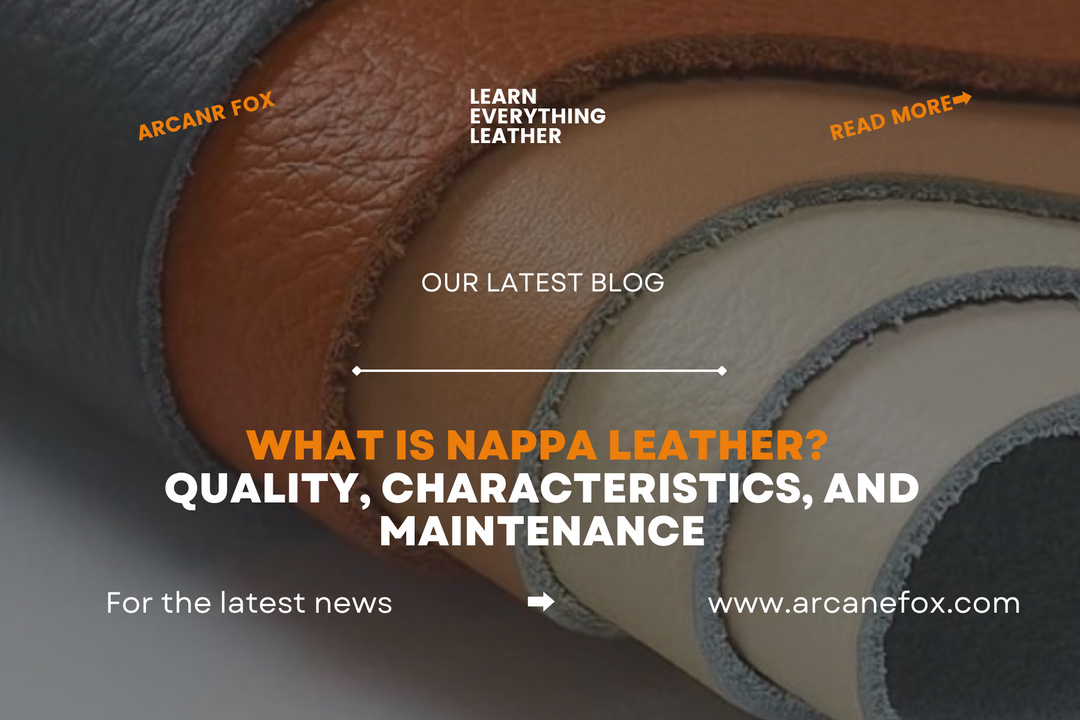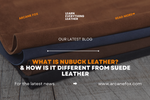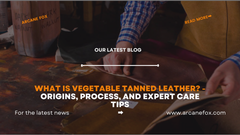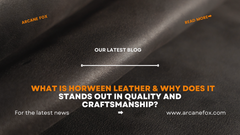What is Nappa Leather? Quality, Characteristics, and Maintenance

What is Nappa Leather? Quality, Characteristics, and Maintenance
Sometimes you are looking for leather with specific qualities, such as being smooth and supple. It's Nappa leather there.
The phrase "Napa" or "Napa leather" refers to leather that is often smooth, supple, and long-lasting. It can be made of any animal and is often made of full-grain leather. Most frequently, it comes from young goats, lambs, and calves. It can also be spelled "Nappa" and is used in many different leather products.
Nappa is distinguished by its quality, which can be found in high-end leather goods. Its history is particularly fascinating. Let's examine the reasons for its popularity.
What to Expect for This Blog?
Discover the Nappa leather world in this extensive blog. Learn about the history, characteristics, and production of nappa leather. Examine the debates around its term and its use to expensive leather goods. Learn how to take care of Nappa leather, including correct cleaning, conditioning, and storing methods. Learn the answers to frequently asked concerns regarding nappa leather, such as its cost, durability, and suitability for jackets. This site includes all the details you need to become knowledgeable about the world of Nappa leather, whether you're a leather fanatic, a fashion expert, or just interested in this pricey material.
1. What is Nappa Leather?

Actually, the name "Nappa leather" only refers to extremely soft, smooth, and durable leather. Since "nappa" is not clearly defined, there is a significant difference in the real leathers' thickness, polish, grain pattern, color, and even the animals from which they are derived.
Nappa leather generally comes from full-grain leather due to its high quality. This piece of leather hasn't been buffed or sanded to get rid of any flaws; it still has the "grain" of the outer layer of the hide. On full-grain leathers, usually, only the hair is removed. The grain often contains fiber, more tightly packed fibers, which produce a surface that is exceptionally robust, resilient, and able to sustain demanding use.
Nappa leather is regularly colored with various dyes. Due to these, it is both attractive and appropriate for various leather goods. Various finishes can also be used to give leather qualities like water and abrasion resistance.
2. Is It Napa Leather or Nappa Leather?
Technically, Napa leather should be spelled Napa. However, throughout time, the spelling Nappa has gained popularity, leading to numerous references to it as Nappa leather. People are likely to grasp what you are talking about when you refer to it either way.
Remember that Napa (or Nappa) leather is only a name and not even a reference with a clear definition in and of itself. Let's look into the past of the name Napa to learn a little more about it.
3. Why is it Called Nappa Leather?

Nathan Coombs came up with the name Nappa in 1847 for a city. Two native tribes in the area of California adopted it as a broad term to designate the city, giving it the name Napa, California.
Emanuel Manasse, a German leather tanner's son, invented Nappa leather for the first time in 1875. He created a leather that is soft, flexible, and resilient while working at the Sawyer Tanning Company, making it ideal for gloves. The name Nappa Leather originated from the region where the leather was produce, Napa, California.
4. Who Invented Napa Leather?
Emanuel Manasse is recognize for creating Napa leather for the first time in 1875. Manasse, the son of a leather tanner, was born in Germany in 1842. In 1864, he moved to New Jersey in the USA. In 1871, he eventually relocated to Napa, California.
While living here, he continued the family business by working at the 1869-founded Sawyer Tanning Company. While I'm here, I should mention that in 1875 he created a leather that was supple, flexible, and ideal for creating gloves. Given the region in which it was create, it later acquired the name Napa Leather.
In 1880, Manasse would go on to join the Sawyer Tanning Company as a partner. He would have a prosperous and successful life. The word "Napa leather," as it was originally known, would later spread throughout the leather industry and come to mean high-quality leather that is flexible, supple, and ideal for exquisite leather goods.
5. How is Nappa Leather Made?

Tanning is the method use to produce Nappa leather. Depending on the procedure employed, tanning can take anywhere from days to months and involves up to 25 processes. A quick chromium tanning procedure is frequently use to tan Napa leathers. Leathers that are tanned with chromium are renowned for being supple and flexible.
Leathers produced by chromium tanning also take and keep colored dye reasonably well. This results in a very aesthetically pleasing, soft leather that may be use for a variety of leather goods, such as bags, gloves, purses, wallets, and other high-end leather items and accessories. Nappa leathers are both physically supple and aesthetically beautiful because they come in a variety of colors.
6. What is The Difference Between Nappa Leather and Other Leather?
The term "nappa" simply indicates a certain type of leather that is particularly supple, smooth, and flexible. Napa refers to a particular subset of leather within the greater set of leathers, even if the leather is a general phrase that can refer to a range of sorts and quality of the material. Definitely genuine leather, Nappa leather.
Nappa leather typically has a natural, high-quality, uncorrected grain surface, but leather in general might have several treatments done that change its surface.
7. What is Nappa Leather Used For?

Numerous high-end leather products are made from Nappa leather. Among the more common uses are:
- Wallets
- Handbags
- Briefcases
- Travel Bags
- Luggage
- Pouches
- Jackets
- Notebook Covers
- Automobile Upholstery
- Furniture Upholstery
- Hats
- Shoes
- Gloves
8. What Brands Use Nappa Leather?
Nappa leather is very popular for upholstery in cars, especially those made by BMW, Mercedes, Audi, and Bentley. Nappa leather is use by manufacturers of luxury goods for wallets, handbags, and personal accessories like gloves. Coach, Prada, Gucci, and Tumi have all created designs.
9. The Controversies of Nappa Leather
Nappa Leather has been involved in a lot of disputes and copyright problems. One of the highest quality types of leather, true Nappa leather is produce by the chromium tanning process. However, most people refer to any soft and smooth leather as "Nappa leather" due to marketing strategies.
9.1 Is Nappa Leather Real Leather?
Yes! It is real leather crafte from full-grain, unaltered hide. Due to their soft and silky texture, calfskin, lambskin, and kid goatskin hides are typically use to create nappa leather.
10. Nappa Leather Care & Maintenance

All leather items, especially those made of Nappa leather, should be cleaned and maintained properly. Keeping the surfaces clean and restoring/conditioning them with oils can help them stay strong and look fantastic because they are made of natural fibers.
One thing to keep in mind is that you should always test any leather care step on a tiny area first to make sure the cleaning or finish won't react negatively with the leather. Clean away as soon as you're certain it's secure.
Nappa leather is particularly sensitive to cleaners if it is unfinished. Even big drops of water can make the substance darker.
10.1 How to Clean Nappa Leather?
In general, you can clean nappa leather by rubbing a wet, lint-free cloth over the surface. It's difficult to strike the right balance between using a damp cloth that will stain the leather (if it's unfinished) and one that is too dry and won't allow it to penetrate and remove dirt, dust, and grime. Dyeing leather will make stains less of a problem.
While it might seem like any water equals instant stain, it normally takes more than a damp cloth to leave any visible evidence since some of the moisture will air-dry off the surface.
A specialized leather cleaner might be a good option if the dirt is more ingrained, it contains challenging stains, or you want to fully clean the leather. To find a leather soap that is delicate enough to clean without damaging really soft leather, look for one that is made for them.
10.2 How to Condition Napa Leather?
The leather fibers of Nappa leather dry out more quickly than on other varieties of leather if no surface finishes are use. Therefore, it's crucial to condition unfinished Nappa leather more frequently.
Usually, this entails slathering the leather with wax, oil, or cream and allowing it to absorb it. The leather feels better in the hand and is more flexible, soft, and scratch-resistant after conditioning.
A soft cloth or applicator can be use to apply the conditioner after the surface has been thoroughly clean. Typically, conditioner is apply in tiny circular motions, allow to absorb, and then the excess is remove with a fresh, lint-free cloth.
If you want a protective coating might be add at this point. The advantage is that it will make the leather slightly more scratch- and water-resistant. The potential drawback is that it might add a layer to the leather's surface, hiding some of the appealing features of natural leather's feel and appearance. Protective coatings are typically made of synthetic waxes/acrylics like resole or natural waxes.
10.3 How to Store Napa Leather?

Most leather should be kept in a place that is cool, dry, and free of dust. Low-average humidity settings are often advantageous for leather items. The ability of the leather's natural fibers to "breathe" is another advantage of airflow.
If maintained in a closed space, the humidity may increase, causing the leather to start to break down and mold. The leather may begin to dry up in an atmosphere with too little humidity, which may cause cracking and weakening of the fibers.
An ideal location to keep Nappa leather is a closet or dressing room with regular circulation, an average humidity level, and tolerable temperatures. Storage bags are include with several leather products. Typically made of permeable material, they aid in keeping you sealed off. If one of these is accessible, storing it there can be a terrific option.
High-quality Nappa leather has an interesting history behind its name and many appealing qualities. Napa leather should be taken into account for a future purchase or leatherworking endeavor.
11. Conclusion
Nappa leather is a wonderful and highly sought-after type of leather, whether it is spell "Napa" or "Nappa," in conclusion. It has a special appeal and heritage because of its history, which dates back to Emanuel Manasse groundbreaking effort in 1875. Nappa leather is use for high-end leather items including wallets, handbags, jackets, and car upholstery because of its softness, flexibility, and high quality.
Nappa leather continues to stand for elegance and craftsmanship despite the debates and controversies that surround the phrase. Its beauty and longevity can be preserve with the help of suitable maintenance, such as cleaning, conditioning, and storage. Nappa leather thus stands as a tribute to the enduring history of high-quality leather manufacturing, whether you're a leather aficionado, a fashion connoisseur, or you're just captivate by this fine material.
Learn more about leather here Leather 101 - The Ultimate Guide to Different Types of Leather
Related Topics
What is Aniline Leather? Types of Aniline, Characteristics, And More
What is Semi-Aniline Leather? History, Characteristics, And More
What is Burnished Leather? & Why Should It’s Be Your Top Choice
What is Antique Leather? & Why it is So Popular
What is Bicast Leather? Myths, Facts, and Benefits
What is Embossed Leather? & How to Use This Process
What is Embroidery Leather? & What to Look for In Leather Embroidery?
What is Faux Leather? It’s Quality & Durability Against Other Leather!
What is Nubuck Leather? & How is it Different From Suede Leather
What is Oil or Pull-Up Leather? It’s Durability, Characteristics, and Maintenance
What is Patent Leather? & How to Maintain It’s Quality and Shining
What is Pigmented Leather? How is it Made, It's uses and characteristics





